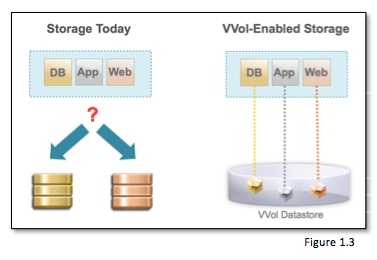Take Charge of Your Storage with a Revolutionary Virtual Volumes as a Service
Technology growing pains and workarounds are simply a matter of life in the IT world, and virtual storage is no exception.
August 28, 2015


Technology growing pains and workarounds are simply a matter of life in the IT world, and virtual storage is no exception. For years, administrators have struggled with limitations of LUN-centric or volume-centric storage, especially in terms of data services such as snapshots, clones and data protection. Moreover, they have found the traditional bottom up paradigm very cumbersome in how to provision storage for workloads and adapt to changing needs. This has left many IT professionals wondering why there isn’t a smarter way to manage storage–one that shifts policy control from being locked up in proprietary hardware to being integrated in an on-demand, pay-as-you-go software-defined, hybrid cloud storage service.
On the vendor side, our service provider partners have faced similar challenges with these legacy technologies. They have been burdened with the complexity and ballooning costs associated with storage hosting, disaster recovery services and maintaining separate data islands. In the end, we all urgently wanted a change in the way storage was provisioned and consumed.
Enter VMware vSphere Virtual Volumes (VVol)–an industry-wide initiative with granular, per-VM management of storage that puts apps in charge. VVol is a new integration and management framework that meets everyone’s needs by virtualizing SAN/NAS arrays, enabling a more efficient operational model that is optimized for virtualized environments and centered on the application instead of the infrastructure. For your customers, this framework offers a simplified point-and-click approach, familiar VMware features and much-needed granular control. It also offers service providers the increased agility, cost savings and operational efficiencies that any CFO would like to see in a value-added service.
A Closer Look at VVol
In today’s “infrastructure-centric” model (shown on left in Figure 1.2), storage pools are pre-confirmed, static and pre-allocated–meaning you cannot easily change them. This creates a “bin packing” problem, where you can fit only a certain amount of VMs into each LUN. Typically, the process produces significant waste (in both resources and time), as well as over-provisioning and performance bottlenecks. As a result, you have to do a lot of data migration, frequent movement and shuffling of VMs in order to efficiently utilize your storage environment. It works today, but it is very wasteful.

Shifting gears to the “app-centric model with VVol“ (image on right in Figure 1.2), you’re able to define storage policy from the top down, apply policy at VM creation, and enable resources to be automatically provisioned and maintained. For admins, there are no complex configurations through LUNs or volumes. You avoid overprovisioning, and can change policies easily and at any time. In essence, VVol shifts the management model for storage from the device to the application. It allows applications to dictate what they need to run and eliminates a fundamental tradeoff that customers have been making when there is a mismatch between application requirements and available storage resources. As shown in Figure 1.3, this results in a more efficient and dynamic storage model that is easy to change on the fly and features fine-grain controls for capacity, performance and availability. This approach to storage makes a lot more sense!

Building A Partnership On The VVol Framework
“Hands-on, sleeves up, eyes and ears open. Working in tandem with you to get the best out of your IT—instead of letting it get the best of you.” This is the philosophy of one of our premier vCloud Air Network partners, Xtium–a cloud and managed service provider based in Philadelphia (with additional dedicated storage areas in Las Vegas). Xtium realized that, while its storage footprint was already significant, it could further expand its reach across the United States by building upon the power of the VVol framework. For this, the company looked to Global Storage Network powered by ClearSky Data. It is a managed network of caching resources residing in metro areas across the world (refer to Figure 1.1 for full details).
With ClearSky Data’s global storage network, Xtium has eliminated the costs and management of replicating data in sync at multiple backup sites, while increasing the compute available at those sites to provide additional value-added services. Unlike legacy, physical storage systems, the ClearSky Data global storage network is designed from the ground up to support VVol and per-workload granularity.
“As a Premier partner in VMware’s vCloud Air™ Network Program, Xtium continues to deliver on the promise of cloud economics with practical deployments. When game-changing technology catches our eye, we aggressively analyze and test in real-world environments first, which allows us to consistently meet this commitment. Through the relationships with VMware and ClearSky Data, our customers will now be able to experience the benefits of VMware vSphere Virtual Volumes and paradigm-breaking global storage network together. This deeper integration with VMware and ClearSky Data has given Xtium a model that can lower the TCO for customers looking to virtualize applications,” said David Rode, Chief Executive Officer of Xtium.
Now, let’s dig deeper into the capabilities available through Xtium’s relationship with VMware and ClearSky Data. The following key benefits will help you embrace the possibilities of Virtual Volumes as a Service:
1. Instant Data Portability
By leveraging the ClearSky Data technology and VVol, Xtium customers can seamlessly migrate workloads, data and storage policies from their data centers to the Xtium cloud. Additionally, Xtium can quickly move workloads across all of its datacenters without the overhead of making and protecting multiple copies of the data. VVol appears at the new location with a simple set of clicks in a vSphere plug-in.
2. Granular, Per-VM Storage Policy-based Management
The ClearSky Data technology augments more conventional storage policies with new capabilities such as options for operating location and metro area clustering. Thus, on a workload-by-workload basis, Xtium can now apply these additional capabilities to more finely manage the tradeoffs between desired performance and protection levels against costs across their datacenters and, eventually, vCloud Air.
3. Storage Consumption Insights
Over time, the service infrastructure “learns” the workloads, providing new insights into how they use the storage across distributed layers. For example, knowledge of how much storage space is “hot, warm and cold” within a workload allows Xtium to fine-tune its policies and control storage costs.
4. Dramatic TCO Savings
Migrating a customer workload goes from days to 15 minutes when it is running on the architecture, greatly increasing uptime. Between the dramatic reduction in these migration times as well as the highly efficient, optimized storage architecture, Xtium is saving 60 percent to 70 percent of the cost to deliver its services versus conventional storage arrays.
Are you ready to take charge of your virtual storage? We’d love to hear your thoughts below.
You can learn about the Xtium/ClearSky Data partnership by visiting the VMware vSphere blog. Or, you can refer directly to the Virtual Volumes Solutions Overview page for key elements of this industry-wide initiative. ClearSky Data will exhibit its solution at VMworld 2015 in San Francisco. Visit the team in booth #441 for a demo, and attend the VMware-led session “What’s New in Virtual Volumes” (STO5571), with guests Laz Vekiarides, ClearSky Data Chief Technology Officer and Co-founder, and Tim Vogel, Chief Technology Officer of Xtium, on Aug. 31 from 2 p.m. to 3 p.m.
 Sanjeev Desai is Global Product Marketing leader at VMware. He is a customer-centric and results-driven leader with expertise in driving transformative business solutions in the Software Defined Enterprise, End User Computing and Hybrid Cloud domains. His professional experience ranges across high-tech industries from the Fortune 500 companies to medium-sized businesses and entrepreneurial startups in Silicon Valley. Guest blogs such as this one are published monthly and are part of Talkin’ Cloud’s annual platinum sponsorship.
Sanjeev Desai is Global Product Marketing leader at VMware. He is a customer-centric and results-driven leader with expertise in driving transformative business solutions in the Software Defined Enterprise, End User Computing and Hybrid Cloud domains. His professional experience ranges across high-tech industries from the Fortune 500 companies to medium-sized businesses and entrepreneurial startups in Silicon Valley. Guest blogs such as this one are published monthly and are part of Talkin’ Cloud’s annual platinum sponsorship.
About the Author
You May Also Like


